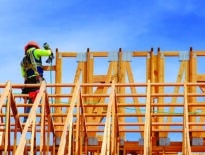
Lew Sichelman
Scrap tires have been recycled for years into building products like flooring, infill decking and septic system drain fields. Actually, entire houses can be built with the millions of tires that are tossed out every year. To build so-called Earthships, for example, whole tires are filled with dirt and covered with concrete to create walls.
But rubber tires are hardly the only items recycled into products for our homes. So are newspapers, glass bottles, wine bottle corks and some of the millions of plastic bags we bring home every day.
How about sargassum, the foul-smelling seaweed that washes up on beaches around the world? Mexican businessman Omar Vazquez Sanchez found a way to make the gunk useful.
He initially collected sargassum to use as fertilizer at his nursery, then later contracted with local resorts to clear the organic muck from their beaches. But instead of tossing the excess, Sanchez decided to see if the stuff could be turned into bricks.
According to trade magazine Green Builder, Sanchez saw the weed as a nearly unlimited source of free fiber which, when mixed with the natural clay soil found where he lived, could form long-lasting bricks. He ground up the weed and tested it with various aggregates to find just the right ratio, all by hand, and called the final product Sargablock.
He’s now built 13 Sargablock houses for low-income families in Quintana Roo, Mexico, and is fielding inquiries from builders in other countries, including the United States.
Ashes to Bricks
Bricks can also be made out of waste from coal-fired power plants. Each year, millions of tons of fine-particle waste called fly ash are recycled, usually into additives for concrete, but millions of tons also go to waste. Now, some of that excess can be formed into bricks.
Unlike conventional clay bricks, which are fired in high-temperature kilns, fly ash bricks are manufactured at room temperature, thereby conserving energy.
And then there’s Lego-like Renco, an interlocking block system invented about a dozen years ago. The blocks are made of recycled glass, plastic, calcite dust and resin, and can withstand anything Mother Nature throws their way. The system can be assembled by following color-coded instructions with little more than a mallet and a glue gun. The company says that construction is significantly faster and cheaper than conventional methods.
Even paper can be “upcycled” back into wood – or at least faux wood. NewspaperWood – invented two decades ago by Dutch designer Mieke Meijer – is created when many pages are glued together, rolled and compressed into solid logs. The logs can be cut, milled, sanded and finished just like real wood, and the layers mimic the growth rings of a tree, making the product as aesthetically pleasing as the real thing.
D.R. Horton Makes Big Move
With a look to the future, America’s largest homebuilder, D.R. Horton, signed a deal last year to purchase 250,000 structural panels made from fast-growing, carbon-capturing perennial grass. Made by Plantd, the panels will be used as walls and roof decking. The first test house went up last summer in Durham, North Carolina.
Glass has also become a big part of the circular economy. Countertops and tiles often come to mind when people think of recycled glass, but there are many other uses. One of the more recent applications is the use of crushed glass as an aggregate in concrete. Recycled glass has also been shaped into shower walls, kitchen backsplashes, tabletop mosaics and architectural glass building blocks. (The blocks aren’t load-bearing, but make interesting accent walls or floors.)
Plastic, of course, takes ages to break down, and only a small percentage of the world’s plastic is successfully recycled. Much depends on whether the resin can be separated from other wastes. But soft drink bottles can be turned into fiberfill for coats and sleeping bags; milk jugs can be made into toys; and polystyrene food containers can be recycled into cafeteria food trays. Plastic can also be turned into “lumber” for park benches, doors and decks.
Some are even using plastic bottles as bricks. Called ecobricks, the bottles are packed tight with small pieces of other plastic waste until they form a solid block that can be used to construct buildings, among other things.
Lew Sichelman has been covering real estate for more than 50 years. He is a regular contributor to numerous shelter magazines and housing and housing-finance industry publications. Readers can contact him at lsichelman@aol.com.






